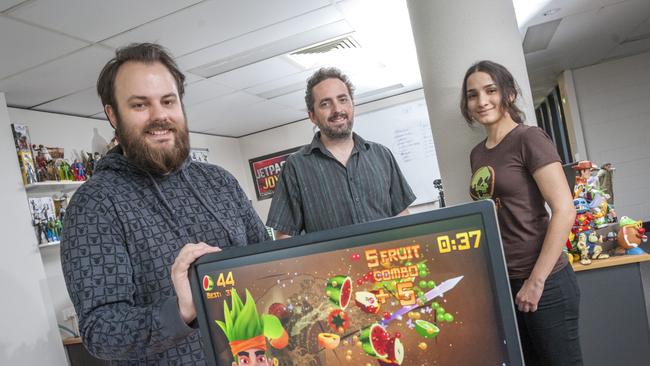Enter the Fruit Ninja: boom times for local ‘app economy’
Australian-designed apps like Fruit Ninja, Workyard and Procreate are creating thousands of jobs in the app economy: report

Australia’s app economy has created 113,000 jobs and has grown at least 11 per cent since 2014, a US report says.
The report by the The Progressive Policy Institute in Washington says the percentage of app economy jobs as a percentage of total jobs was higher in Australia than in Europe but lagged behind the US.
“Australia has an app intensity of 0.9 per cent. By comparison, Europe has an app intensity of 0.8 per cent, while the US app intensity is 1.1 per cent,” it says.
The report, The Rise of The Australian App Economy, makes the case for how technology is creating employment as jobs disappear due to technological disruption.
It includes statistics about app-related jobs on a state-by-state basis. App jobs in NSW are almost double those in Victoria.
It says more than 56,000 workers are employed in the app economy in NSW, 29,000 in Victoria, and 14,500 in Queensland.
Report co-author and PPI chief economic strategist Michael Mandel says the Australian app economy is “remarkably diverse, both in industry and geography”.
“A surprisingly broad range of enterprises are searching for workers across the country who have the ability to design, develop, maintain or support mobile applications,” Dr Mandel says.
He says the fact apps are exportable to any country means the Australian app economy can become a basis for continued growth. “In addition, apps can improve the efficiency and attractiveness of the Australian economy.”
The report says the invention of the smartphone was one of the two most important technological innovations over the past decade, from the perspective of economic impact.
It says Apple’s iPhone and App Store are the beginnings of a global app economy — an army of app developers writing mobile applications for billions of users.
Unlike traditional industries, governments found it hard to quantify its economic impact.
“For example, statistical agencies that count exports have no category in trade statistics for the revenues generated by the export of domestically-created apps to other countries, even though these revenues may be very significant. Indeed, statisticians may not be counting these exports at all.”
It says the other reason for the report was because of the recent debate on whether technology destroys jobs.
There’s a pervasive worry, especially in the aftermath of the financial crisis, that new technologies destroy jobs without creating very many new ones,” the report says.
“So we see reputable business publications like Fortune and the Wall Street Journal run articles with titles like ‘Silicon Valley Is Not a Job Creator’ and ‘Wireless Jobs Evaporate Even As Industry Expands’.
“Unfortunately, government economic statistics are much better at tracking the reduction of existing jobs than identifying the growth of new types of jobs. This lack of data made it harder to measure the employment impact of the Internet and the New Economy.”
According to Apple, App Store customers had downloaded more than 180 billion apps, and Apple has paid more than US$70 billion ($91bn) to developers since the store launched in 2008.
These Australian-developed apps have proved highly successful on the world stage:
• Fruit Ninja. It is the second most downloaded game in the history of the App Store
• HeadCheck. It helps parents and coaches recognise the signs and symptoms of concussion in children
• Workyard. A construction app that makes it easier to source subcontractors for a construction project
• Procreate. A mobile device painting app
• Zova. It focuses on helping people fit short, achievable exercises into everyday life
• Emojifit Diabetes. It uses emoji to communicate type 2 Diabetes information to disadvantaged populations


